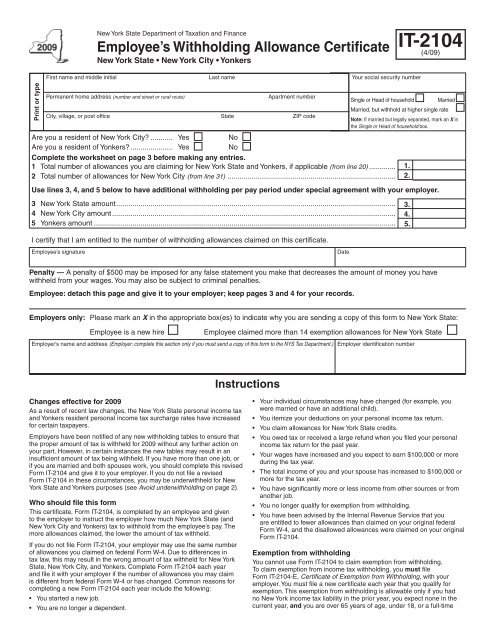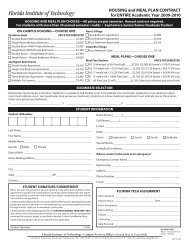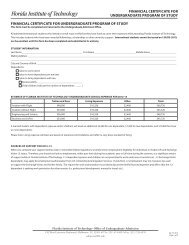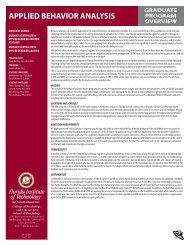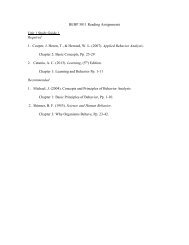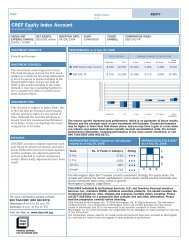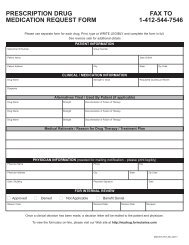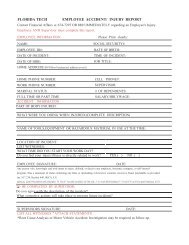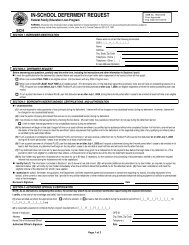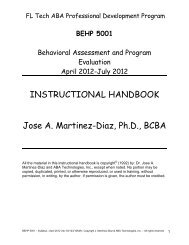Form IT-2104:4/09:Employee's Withholding Allowance Certificate ...
Form IT-2104:4/09:Employee's Withholding Allowance Certificate ...
Form IT-2104:4/09:Employee's Withholding Allowance Certificate ...
Create successful ePaper yourself
Turn your PDF publications into a flip-book with our unique Google optimized e-Paper software.
Print or type<br />
New York State Department of Taxation and Finance<br />
Employee’s <strong>Withholding</strong> <strong>Allowance</strong> <strong>Certificate</strong><br />
New York State • New York City • Yonkers<br />
First name and middle initial Last name Your social security number<br />
Permanent home address (number and street or rural route) Apartment number<br />
City, village, or post office State ZIP code<br />
Are you a resident of New York City? ........... Yes No<br />
Are you a resident of Yonkers? ..................... Yes No<br />
Complete the worksheet on page 3 before making any entries.<br />
1 Total number of allowances you are claiming for New York State and Yonkers, if applicable (from line 20) ............. 1.<br />
2 Total number of allowances for New York City (from line 31) ................................................................................... 2.<br />
<strong>IT</strong>-<strong>2104</strong><br />
(4/<strong>09</strong>)<br />
Single or Head of household Married<br />
Married, but withhold at higher single rate<br />
Note: If married but legally separated, mark an X in<br />
the Single or Head of household box.<br />
Use lines 3, 4, and 5 below to have additional withholding per pay period under special agreement with your employer.<br />
3 New York State amount .......................................................................................................................................... 3.<br />
4 New York City amount ............................................................................................................................................ 4.<br />
5 Yonkers amount ..................................................................................................................................................... 5.<br />
I certify that I am entitled to the number of withholding allowances claimed on this certificate.<br />
Employee’s signature Date<br />
Penalty — A penalty of $500 may be imposed for any false statement you make that decreases the amount of money you have<br />
withheld from your wages. You may also be subject to criminal penalties.<br />
Employee: detach this page and give it to your employer; keep pages 3 and 4 for your records.<br />
Employers only: Please mark an X in the appropriate box(es) to indicate why you are sending a copy of this form to New York State:<br />
Employee is a new hire Employee claimed more than 14 exemption allowances for New York State<br />
Employer’s name and address (Employer: complete this section only if you must send a copy of this form to the NYS Tax Department.) Employer identification number<br />
Changes effective for 20<strong>09</strong><br />
As a result of recent law changes, the New York State personal income tax<br />
and Yonkers resident personal income tax surcharge rates have increased<br />
for certain taxpayers.<br />
Employers have been notified of any new withholding tables to ensure that<br />
the proper amount of tax is withheld for 20<strong>09</strong> without any further action on<br />
your part. However, in certain instances the new tables may result in an<br />
insufficient amount of tax being withheld. If you have more than one job, or<br />
if you are married and both spouses work, you should complete this revised<br />
<strong>Form</strong> <strong>IT</strong>-<strong>2104</strong> and give it to your employer. If you do not file a revised<br />
<strong>Form</strong> <strong>IT</strong>-<strong>2104</strong> in these circumstances, you may be underwithheld for New<br />
York State and Yonkers purposes (see Avoid underwithholding on page 2).<br />
Who should file this form<br />
This certificate, <strong>Form</strong> <strong>IT</strong>-<strong>2104</strong>, is completed by an employee and given<br />
to the employer to instruct the employer how much New York State (and<br />
New York City and Yonkers) tax to withhold from the employee’s pay. The<br />
more allowances claimed, the lower the amount of tax withheld.<br />
If you do not file <strong>Form</strong> <strong>IT</strong>-<strong>2104</strong>, your employer may use the same number<br />
of allowances you claimed on federal <strong>Form</strong> W-4. Due to differences in<br />
tax law, this may result in the wrong amount of tax withheld for New York<br />
State, New York City, and Yonkers. Complete <strong>Form</strong> <strong>IT</strong>-<strong>2104</strong> each year<br />
and file it with your employer if the number of allowances you may claim<br />
is different from federal <strong>Form</strong> W-4 or has changed. Common reasons for<br />
completing a new <strong>Form</strong> <strong>IT</strong>-<strong>2104</strong> each year include the following:<br />
• You started a new job.<br />
• You are no longer a dependent.<br />
Instructions<br />
• Your individual circumstances may have changed (for example, you<br />
were married or have an additional child).<br />
• You itemize your deductions on your personal income tax return.<br />
• You claim allowances for New York State credits.<br />
• You owed tax or received a large refund when you filed your personal<br />
income tax return for the past year.<br />
• Your wages have increased and you expect to earn $100,000 or more<br />
during the tax year.<br />
• The total income of you and your spouse has increased to $100,000 or<br />
more for the tax year.<br />
• You have significantly more or less income from other sources or from<br />
another job.<br />
• You no longer qualify for exemption from withholding.<br />
• You have been advised by the Internal Revenue Service that you<br />
are entitled to fewer allowances than claimed on your original federal<br />
<strong>Form</strong> W-4, and the disallowed allowances were claimed on your original<br />
<strong>Form</strong> <strong>IT</strong>-<strong>2104</strong>.<br />
Exemption from withholding<br />
You cannot use <strong>Form</strong> <strong>IT</strong>-<strong>2104</strong> to claim exemption from withholding.<br />
To claim exemption from income tax withholding, you must file<br />
<strong>Form</strong> <strong>IT</strong>-<strong>2104</strong>-E, <strong>Certificate</strong> of Exemption from <strong>Withholding</strong>, with your<br />
employer. You must file a new certificate each year that you qualify for<br />
exemption. This exemption from withholding is allowable only if you had<br />
no New York income tax liability in the prior year, you expect none in the<br />
current year, and you are over 65 years of age, under 18, or a full-time
Page 2 of 4 <strong>IT</strong>-<strong>2104</strong> (4/<strong>09</strong>)<br />
student under 25. If you are a dependent who is under 18 or a full-time<br />
student, you may owe tax if your income is more than $3,000.<br />
<strong>Withholding</strong> allowances<br />
You may not claim a withholding allowance for yourself or, if married,<br />
your spouse. Claim the number of withholding allowances you compute<br />
in Part 1 and Part 3 on page 3 of this form. If you want more tax withheld,<br />
you may claim fewer allowances. If you claim more than 14 allowances,<br />
your employer must send a copy of your <strong>Form</strong> <strong>IT</strong>-<strong>2104</strong> to the New York<br />
State Tax Department. You may then be asked to verify your allowances.<br />
If you arrive at negative allowances (less than zero) on lines 1, 2, 20, or<br />
31, and your employer cannot accommodate negative allowances, enter 0<br />
and see Additional dollar amount(s) below.<br />
Income from sources other than wages — If you have more than<br />
$1,000 of income from sources other than wages (such as interest,<br />
dividends, or alimony received), reduce the number of allowances<br />
claimed on line 1 and line 2 (if applicable) of the <strong>IT</strong>-<strong>2104</strong> certificate by one<br />
for each $1,000 of nonwage income. If you arrive at negative allowances<br />
(less than zero), see <strong>Withholding</strong> allowances above. You may also<br />
consider filing estimated tax, especially if you have significant amounts of<br />
nonwage income. Estimated tax requires that payments be made by the<br />
employee directly to the Tax Department on a quarterly basis. For more<br />
information, see the instructions for <strong>Form</strong> <strong>IT</strong>-2105, Estimated Income Tax<br />
Payment Voucher for Individuals, or see Need help? below.<br />
Other credits (Worksheet line 13) — If you will be eligible to claim<br />
any credits other than the credits listed in the worksheet, such as an<br />
investment tax credit, you may claim additional allowances as follows:<br />
• If you expect your New York adjusted gross income to be less than<br />
$300,000, divide the amount of the expected credit by 70 and enter the<br />
result (rounded to the nearest whole number) on line 13.<br />
• If you expect your New York adjusted gross income to be between<br />
$300,000 and $500,000, divide the amount of the expected credit by 80<br />
and enter the result (rounded to the nearest whole number) on line 13.<br />
• If you expect your New York adjusted gross income to be over<br />
$500,000, divide the amount of the expected credit by 90 and enter the<br />
result (rounded to the nearest whole number) on line 13.<br />
Example: You expect your New York adjusted gross income to be<br />
less than $300,000. In addition, you expect to receive a flow-through<br />
of an investment tax credit from the S corporation of which you are a<br />
shareholder. The investment tax credit will be $160. Divide the expected<br />
credit by 70. 160/70 = 2.2857. The additional withholding allowance(s)<br />
would be 2. Enter 2 on line 13.<br />
Married couples with both spouses working — If you and your spouse<br />
both work, you should each file a separate <strong>IT</strong>-<strong>2104</strong> certificate with your<br />
respective employers. You should each mark an X in the box Married,<br />
but withhold at higher single rate on the certificate front, and divide the<br />
total number of allowances that you compute on line 20 and line 31 (if<br />
applicable) between you and your working spouse. Your withholding will<br />
better match your total tax if the higher wage-earning spouse claims all of<br />
the couple’s allowances and the lower wage‑earning spouse claims zero<br />
allowances. Do not claim more total allowances than you are entitled to.<br />
If you and your spouse’s combined wages are between $100,000 and<br />
$1,100,000, use one of the charts in Part 4 to compute the number of<br />
allowances to transfer to line 19.<br />
Taxpayers with more than one job — If you have more than one<br />
job, file a separate <strong>IT</strong>-<strong>2104</strong> certificate with each of your employers. Be<br />
sure to claim only the total number of allowances that you are entitled<br />
to. Your withholding will better match your total tax if you claim all of<br />
your allowances at your higher‑paying job and zero allowances at the<br />
lower-paying job. In addition, to make sure that you have enough tax<br />
withheld, if you are a single taxpayer or head of household with two or<br />
more jobs, reduce the number of allowances by six on line 1 and line 2 (if<br />
applicable) on the certificate you file with your higher-paying job employer.<br />
If you arrive at negative allowances (less than zero), see <strong>Withholding</strong><br />
allowances above.<br />
If your combined wages are between $100,000 and $1,100,000, use one<br />
of the charts in Part 4 to compute the number of allowances to transfer to<br />
line 19. Substitute the words Highest paying job for Higher earner’s wages<br />
within the charts.<br />
Dependents — If you are a dependent of another taxpayer and expect<br />
your income to exceed $3,000, you should reduce your withholding<br />
allowances by one for each $1,000 of income over $2,500. This will<br />
ensure that your employer withholds enough tax.<br />
Following the above instructions will help to ensure that you will not owe<br />
additional tax when you file your return.<br />
Heads of households with only one job — If you will use the head-ofhousehold<br />
filing status on your state income tax return, mark the Single<br />
or Head of household box on the front of the certificate. If you have only<br />
one job, you may also wish to claim two additional withholding allowances<br />
on line 14.<br />
Married couples with only one spouse working — If your spouse does<br />
not work and has no income subject to state income tax, mark the<br />
Married box on the front of the certificate. You may also wish to claim two<br />
additional allowances on line 15.<br />
Additional dollar amount(s)<br />
You may ask your employer to withhold an additional dollar amount each<br />
pay period by completing lines 3, 4, and 5 on <strong>Form</strong> <strong>IT</strong>-<strong>2104</strong>. In most<br />
instances, if you compute a negative number of allowances using the<br />
worksheet on page 3 and your employer cannot accommodate a negative<br />
number, for each negative allowance claimed you should have an<br />
additional $2.10 of tax withheld per week for New York State withholding<br />
on line 3, and an additional $0.80 of tax withheld per week for New York<br />
City withholding on line 4. Yonkers residents should use 10% (.10) of the<br />
New York State amount for additional withholding for Yonkers on line 5.<br />
Note: If you are requesting that your employer withhold an additional<br />
dollar amount on lines 3, 4, or 5 of this allowance certificate, the<br />
additional dollar amount, as determined by these instructions or by using<br />
the chart in Part 4, is accurate for a weekly payroll. Therefore, if you are<br />
paid other than weekly, you will need to adjust the dollar amount(s) that<br />
you compute. For example, if you are paid biweekly, you must double the<br />
dollar amount(s) computed using the worksheet on page 3.<br />
Avoid underwithholding<br />
<strong>Form</strong> <strong>IT</strong>-<strong>2104</strong>, together with your employer’s withholding tables, is<br />
designed to ensure that the correct amount of tax is withheld from your<br />
pay. If you fail to have enough tax withheld during the entire year, you may<br />
owe a large tax liability when you file your return. The Tax Department<br />
must assess interest and may impose penalties in certain situations<br />
in addition to the tax liability. Even if you do not file a return, we may<br />
determine that you owe personal income tax, and we may assess interest<br />
and penalties on the amount of tax that you should have paid during the<br />
year.<br />
Privacy notification<br />
The Commissioner of Taxation and Finance may collect and maintain personal information<br />
pursuant to the New York State Tax Law, including but not limited to, sections 5-a, 171,<br />
171‑a, 287, 308, 429, 475, 505, 697, 1<strong>09</strong>6, 1142, and 1415 of that Law; and may require<br />
disclosure of social security numbers pursuant to 42 USC 405(c)(2)(C)(i).<br />
This information will be used to determine and administer tax liabilities and, when<br />
authorized by law, for certain tax offset and exchange of tax information programs as well<br />
as for any other lawful purpose.<br />
Information concerning quarterly wages paid to employees is provided to certain state<br />
agencies for purposes of fraud prevention, support enforcement, evaluation of the<br />
effectiveness of certain employment and training programs and other purposes authorized<br />
by law.<br />
Failure to provide the required information may subject you to civil or criminal penalties, or<br />
both, under the Tax Law.<br />
This information is maintained by the Director of Records Management and Data<br />
Entry, NYS Tax Department, W A Harriman Campus, Albany NY 12227; telephone<br />
1 800 225-5829. From areas outside the United States and outside Canada, call<br />
(518) 485-6800.<br />
Need help?<br />
Internet access: www.nystax.gov<br />
Get answers to frequently asked questions; check your refund<br />
status; check your estimated tax account; download forms, publications;<br />
get tax updates and other information.<br />
Telephone assistance is available from 8:00 A.M. to 5:00 P.M.<br />
(eastern time), Monday through Friday.<br />
To order forms and publications: 1 800 462-8100<br />
Refund status: 1 800 443‑3200<br />
Personal Income Tax Information Center: 1 800 225-5829<br />
From areas outside the U.S. and outside Canada: (518) 485-6800<br />
Fax-on-demand forms: <strong>Form</strong>s are available<br />
24 hours a day, 7 days a week. 1 800 748-3676<br />
Text Telephone (TTY) Hotline (for persons with<br />
hearing and speech disabilities using a TTY): 1 800 634-2110
Worksheet<br />
<strong>IT</strong>-<strong>2104</strong> (4/<strong>09</strong>) Page 3 of 4<br />
Part 1 — Complete this part to compute your withholding allowances for New York State and Yonkers (line 1).<br />
6 Enter the number of dependents that you will claim on your state return (do not include yourself or, if married, your spouse) ... 6.<br />
For lines 7, 8, and 9, enter 1 for each credit you expect to claim on your state return.<br />
7 College tuition credit ................................................................................................................................................................... 7.<br />
8 New York State household credit ................................................................................................................................................ 8.<br />
9 Real property tax credit ............................................................................................................................................................... 9.<br />
For lines 10, 11, and 12, enter 3 for each credit you expect to claim on your state return.<br />
10 Child and dependent care credit ................................................................................................................................................ 10.<br />
11 Earned income credit ................................................................................................................................................................ 11.<br />
12 Empire State child credit ........................................................................................................................................................... 12.<br />
13 Other credits (see instructions) ..................................................................................................................................................... 13.<br />
For lines 14 and 15, enter 2 if either situation applies.<br />
14 Head of household status and only one job .............................................................................................................................. 14.<br />
15 Married couples with only one spouse working and only one job ............................................................................................. 15.<br />
16 Enter an estimate of your federal adjustments to income, such as alimony you will pay for the tax year<br />
and deductible IRA contributions you will make for the tax year. Total estimate $ .<br />
Divide this estimate by $1,000. Drop any fraction and enter the number ............................................................................... 16.<br />
17 If you expect to itemize deductions on your state tax return, complete Part 2 below and enter the number from line 28.<br />
All others enter 0 .................................................................................................................................................................... 17.<br />
18 Add lines 6 through 17 ............................................................................................................................................................... 18.<br />
19 If you have more than one job, or are married with both spouses working, and your combined wages are between<br />
$100,000 and $1,100,000, enter the appropriate number from one of the charts in Part 4. All others enter 0 ..................... 19.<br />
20 Subtract line 19 from line 18. Enter the result, including negative amounts, here and on line 1. If your employer cannot<br />
accommodate negative allowances, enter 0 here and on line 1 and see Additional dollar amounts in the instructions.<br />
(If you have more than one job, or if you and your spouse both work, see instructions.) ....................................................... 20.<br />
Part 2 — Complete this part only if you expect to itemize deductions on your state return.<br />
21 Enter your estimated federal itemized deductions for the tax year............................................................................................ 21.<br />
22 Enter your estimated state, local, and foreign income taxes included on line 21 (if your estimated New York AGI is over $1 million,<br />
you must enter on line 22 all estimated federal itemized deductions included on line 21 except charitable contributions). ......................... 22.<br />
23 Subtract line 22 from line 21 ..................................................................................................................................................... 23.<br />
24 Enter your estimated college tuition itemized deduction ........................................................................................................... 24.<br />
25 Add lines 23 and 24 .................................................................................................................................................................. 25.<br />
26 Based on your federal filing status, enter the applicable amount from the table below ............................................................. 26.<br />
Standard deduction table<br />
Single (cannot be claimed as a dependent) ... $ 7,500 Qualifying widow(er) ......................................... $15,000<br />
Single (can be claimed as a dependent) ........ $ 3,000 Married filing jointly ........................................... $15,000<br />
Head of household .......................................... $10,500 Married filing separate returns .......................... $ 7,500<br />
27 Subtract line 26 from line 25 (if line 26 is larger than line 25, enter 0 here and on line 17 above) ........................................................ 27.<br />
28 Divide line 27 by $1,000. Drop any fraction and enter the result here and on line 17 above .................................................... 28.<br />
Part 3 — Complete this part to compute your withholding allowances for New York City (line 2).<br />
29 Enter the amount from line 6 above .......................................................................................................................................... 29.<br />
30 Add lines 14 through 17 above and enter total here ................................................................................................................. 30.<br />
31 Add lines 29 and 30. Enter the result here and on line 2........................................................................................................... 31.<br />
(continued on page 4)
Page 4 of 4 <strong>IT</strong>-<strong>2104</strong> (4/<strong>09</strong>)<br />
Part 4 — These charts are for taxpayers with more than one job, or married couples with both spouses working, and combined wages<br />
between $100,000 and $1,100,000. All others do not have to use these charts.<br />
Enter the number of allowances (top number) on line 19; or the additional withholding (bottom dollar amount) on line 3.<br />
Higher<br />
earner’s<br />
wages<br />
$100,000<br />
to<br />
120,000<br />
$120,000<br />
to<br />
140,000<br />
$140,000<br />
to<br />
160,000<br />
Combined wages between $100,000 and $500,000<br />
$160,000<br />
to<br />
180,000<br />
$180,000<br />
to<br />
220,000<br />
$220,000<br />
to<br />
260,000<br />
$260,000<br />
to<br />
300,000<br />
$300,000<br />
to<br />
350,000<br />
Combined wages between $500,000 and $1,100,000<br />
$350,000<br />
to<br />
400,000<br />
$400,000<br />
to<br />
450,000<br />
$ 55,000 – 9 11<br />
$ 70,000 $12 $15<br />
$ 70,000 – 9 13 17<br />
$ 90,000 $12 $17 $22<br />
$ 90,000 – 5 10 13 14 15<br />
$110,000 $8 $15 $20 $22 $23<br />
$110,000 – 1 6 10 11 13 12<br />
$120,000 $2 $10 $16 $18 $21 $20<br />
$120,000 – 3 9 10 12 11<br />
$130,000 $4 $14 $16 $19 $17<br />
$130,000 – 1 6 8 10 11 9<br />
$140,000 $2 $10 $13 $16 $17 $13<br />
$140,000 – 3 7 9 11 7<br />
$150,000 $4 $11 $14 $17 $11<br />
$150,000 – 1 6 8 11 8 13<br />
$160,000 $2 $8 $12 $16 $12 $18<br />
$160,000 – 2 8 10 10 42<br />
$180,000 $3 $11 $14 $14 $59<br />
$180,000 – 4 8 11 44 82<br />
$220,000 $6 $11 $15 $62 $116<br />
$220,000 – 4 8 47 84 93 103<br />
$260,000 $6 $11 $66 $119 $131 $145<br />
$260,000 – 4 44 88 93 103<br />
$300,000 $6 $62 $124 $132 $145<br />
$300,000 – 10 20 26 28<br />
$350,000 $33 $70 $88 $95<br />
$350,000 – 6 16 26<br />
$400,000 $11 $27 $45<br />
$400,000 – 6 16<br />
$450,000 $11 $27<br />
$450,000 – 6<br />
$500,000 $11<br />
Higher<br />
earner’s<br />
wages<br />
$500,000<br />
to<br />
550,000<br />
$550,000<br />
to<br />
600,000<br />
$600,000<br />
to<br />
650,000<br />
$650,000<br />
to<br />
700,000<br />
$700,000<br />
to<br />
750,000<br />
$750,000<br />
to<br />
800,000<br />
$800,000<br />
to<br />
850,000<br />
$850,000<br />
to<br />
900,000<br />
$900,000<br />
to<br />
950,000<br />
$950,000<br />
to<br />
1,000,000<br />
$1,000,000<br />
to<br />
1,050,000<br />
$450,000<br />
to<br />
500,000<br />
$1,050,000<br />
to<br />
1,100,000<br />
$260,000 – 175<br />
$300,000 $248<br />
$300,000 – 58 91 101<br />
$350,000 $198 $312 $347<br />
$350,000 – 82 149 169 190 152<br />
$400,000 $140 $254 $289 $325 $259<br />
$400,000 – 78 141 162 182 203 165 177<br />
$450,000 $133 $240 $275 $310 $346 $280 $301<br />
$450,000 – 68 137 153 174 194 216 177 189 202<br />
$500,000 $116 $233 $261 $296 $331 $367 $301 $322 $343<br />
$500,000 – 10 24 31 37 43 50 57 44 48 52 56<br />
$550,000 $55 $126 $165 $193 $228 $263 $299 $233 $254 $275 $296<br />
$550,000 – 8 23 41 54 71 87 104 73 83 93 103<br />
$600,000 $16 $48 $87 $114 $150 $185 $220 $155 $176 $197 $218<br />
$600,000 – 8 23 41 54 71 87 104 73 83 93<br />
$650,000 $16 $48 $87 $114 $150 $185 $220 $155 $176 $197<br />
$650,000 – 8 23 41 54 71 87 104 73 83<br />
$700,000 $16 $48 $87 $114 $150 $185 $220 $155 $176<br />
$700,000 – 8 23 41 54 71 87 104 73<br />
$750,000 $16 $48 $87 $114 $150 $185 $220 $155<br />
$750,000 – 8 23 41 54 71 87 104<br />
$800,000 $16 $48 $87 $114 $150 $185 $220<br />
$800,000 – 8 23 41 54 71 87<br />
$850,000 $16 $48 $87 $114 $150 $185<br />
$850,000 – 8 23 41 54 71<br />
$900,000 $16 $48 $87 $114 $150<br />
$900,000 – 8 23 41 54<br />
$950,000 $16 $48 $87 $114<br />
$950,000 – 8 23 41<br />
$1,000,000 $16 $48 $87<br />
$1,000,000 – 8 23<br />
$1,050,000 $16 $48<br />
$1,050,000 – 8<br />
$1,100,000 $16


